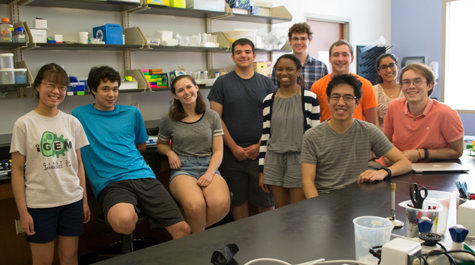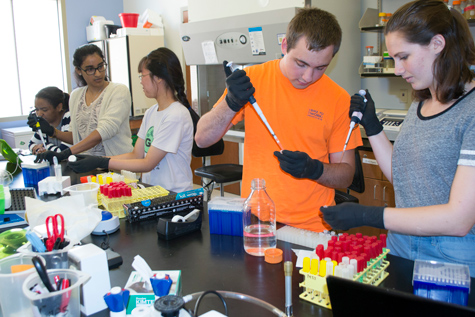William & Mary prepares to defend its 2015 iGEM championship title
William & Mary’s iGEM team knows it has big shoes to fill, so they’ve been hard at work on its 2016 project. Team Captain John Marken offers a hint of what’s to come: “It’s going to be bigger than last year,” Marken said. “Much, much bigger.”
That’s a tall order, considering that last year’s iGEM team took the Grand Prize back to William & Mary from the “World Cup of Science,” the Giant Jamboree held annually by the International Genetically Engineered Machine (iGEM) Foundation.
William & Mary iGEM will defend the world championship title at this year’s Jamboree in Boston on Oct. 27-31. William & Mary’s 2015 project competed alongside those of teams from the world’s largest and most influential research universities, including Germany’s Heidelberg University, which was trying for an iGEM three-peat.
This year’s title-defense team includes Marken ’17, a mathematics major; Kalen Clifton ’18, majoring in biology and computational and applied mathematics and statistics (CAMS); Christine Gao ’17, biology/CAMS; Ethan Jones ’19, undeclared, but leaning toward biology “and maybe something else”; Likhitha Kolla ’18, biology/chemistry; Joe Maniaci ’18, chemistry/CAMS; John Mitchell ’19, physics “and most likely math”; Callan Monette ’19, planning on declaring neuroscience and possibly CAMS; and Adam Reiss ’18; biology/CAMS.
The 2016 team has a solid core of iGEM veterans. Marken and Maniaci were both members of the Grand Prize-winning 2015 team and Gao participated in 2014. Andy Halleran ’16, last year’s co-captain, has returned this summer to serve in an advisory capacity and Chancellor Professor of Biology Margaret Saha is the lead faculty mentor to the team, as she has been since its inception in 2014.
“The 2015 team accomplished a truly phenomenal achievement through hard work, creative thinking — and an excellent project idea,” Saha said.
The arena of competitive collegiate synthetic biology may seem obscure, but the competition is unbelievably stiff. William & Mary’s team joined 259 other groups in Boston last fall, representing an international who’s-who of Big Research. Institutions from every continent were present at the competition, including Tokyo Tech in Japan, Technion University in Israel, Cambridge University in the UK, and UCLA in California.
Markus Gershater, chief scientific officer of the London-based bioengineering firm Synthace Ltd., was a judge of the 2015 iGEM competition. Gershater offered an explanation of the field and iGEM’s role in it following William & Mary’s 2015 Grand Prize victory.
“Synthetic biology is trying to bring engineering rigor and predictiveness to biological systems. This means that we need sophisticated views into the highly dynamic nanoscale world of biological functions, and we need to get those functions measured, characterized and quantified,” Gershater said. “Once we have well- characterized biological parts, then the process of reprogramming biological systems to do useful, world-changing functions will be ever more rapid and capable. In this way, the measurement of different characteristics of these parts underpins everything the field is trying to achieve.”
iGEM is all about the characterization and understanding of the biological parts Gershater mentioned. Teams begin with identical kits of BioBricks, parts selected from iGEM’s Standard Registry of Biological Parts. The BioBrick kit is often referred to as “biological Legos.” The challenge to the competitors is, essentially: take your BioBricks and engineer something. The field of synthetic biology is new enough and sufficiently vast in scope and opportunity that hard-working undergraduate teams can make vital, ground-floor contributions to the science.
“Synthetic biology is a relatively new field and there are a lot of foundational things that need to be taken care of,” Maniaci explained. “Not a lot of people are interested in going through and characterizing individual parts and looking at the nuances and difference in performance. We try to ask ourselves not only why we’re doing a particular thing, but how it will affect the usability of the project. When we design a part in a certain way, we try to characterize it thoroughly. Everything we do, we do because we want people to be able to use it as much as possible.”
William & Mary’s winning 2015 entry was titled “Measurement of Promoter-Based Transcriptional Noise for Application in Gene Network Design.” It rose to the top for a number of reasons, many of which centered around the usefulness of the submission. Jacob Beal, a scientist at Raytheon BBN Technologies, another iGEM judge, addressed the utility of the William & Mary entry on Twitter.
“To do safe and reliable biological engineering, we need predictably behaving cells,” he tweeted. “W&M iGEM is helping measure predictability.”
Many of the projects in an iGEM competition are often application-oriented, focusing on accomplishing a specific task rather than providing foundational insights into the science behind the engineering. The 2016 iGEM team understands why last year’s project was so successful and in addition to “more,” Marken says “more useful” is part of the 2016 motto.
The ambitious scope of the project is made manageable by hard work, enthusiasm and what Halleran calls “institutional memory.” William & Mary first entered the iGEM competition in 2014, notching a bronze award, and since then the team has advanced in many ways .
“The first year, it was really hard,” Halleran said. “Things didn’t work at all! There are a lot of reasons why, but over the years you get this buildup of institutional memory.”
He went on to explain that experience has given the team a better grasp on everything from nuts and bolts lab savvy such as the best cloning methods, primer design and enzyme selection to strategic questions like what makes a good project, how to design a project and what makes it likely to succeed.
“Having that institutional memory has helped a lot. But people have been doing an incredible job,” Halleran said. “In terms of the scale of the project, it’s probably three or four times larger than what we did last year. But where we are now, we’ve probably completed twice or three times as much work as we’d done last year in total.”
“More” and “more useful” are coming together in the form of the 2016 project, which the team calls the Circuit Control Toolbox. The toolbox addresses a set of the knottiest problems in synthetic biology.
“The whole idea behind synthetic biology is to engineer these complicated circuits that do something: detect a toxin, serve as a sensor — something,” Saha explained. “However, our team has identified a number of problems in that we can’t easily control the bits and pieces of these circuits so that we know what the end result will be. So there’s an issue with controlling all the pieces inside the entire circuit.”
The Circuit Control Toolbox is an ambitious project, consisting of the creation and characterization of a set of biological parts designed to allow modification — and control — of genetic circuits, much as diodes and resistors modify and control the output of electronic circuits. The Toolbox offers a big step toward the engineering of predictably behaving cells by offering parts of biological circuits that, thanks to William & Mary’s iGEM project, have a known transfer function.
“A transfer function is simply the input of a circuit graphed against its output,” Saha explained. “So if we know the level of input, we can better predict the level of output.”
Biology has become increasingly computational throughout the field, and the engineering aspects of synthetic biology are especially math-heavy. Caroline Golino ’17, last year’s team co-captain along with Halleran, described the 2015 project as “very bio-mathy.”
The Toolbox is also a very bio-mathy offering. Wet lab activities (the bio part) and computational work (the mathy bits) go on in adjacent facilities in the Integrated Science Center. The computational strength of the 2016 team allows them to further up the utility ante of the Toolbox in the form of a Circuit Control Calculator. A biological circuit designer will be able to plug a desired output into the Circuit Control Calculator, which will tell which of the parts in the Toolbox to use as inputs.
Building the Toolbox and Calculator is an ambitious goal and requires strong new team members to join iGEM veterans Marken, Maniaci and Gao. New members of the team were selected from a pool of around 30 applicants. Saha said the review panel prioritized enthusiasm and scientific curiosity over experience. The team includes a number of rising sophomores.
“I was actually in a physics lab with Joe when I heard about this,” said Mitchell. “He basically said they need more mathematics/quantitative people for the project. And so I said, sure, I’ll do it. And of course, I haven’t really had any biology classes since the freshman year of high school. So I really knew no biology before coming to iGEM.”
Mitchell did some wet lab work, but now mainly works on the mathematical modeling aspect of the project. Like Mitchell, Monette, another rising sophomore, began working at iGEM without extensive lab experience.
“The first couple of weeks were outside my comfort zone, because I didn’t work in the lab my freshman year,” Monette said. She added that the early days were a crash course in lab procedure. “We would work in pairs in the beginning but after we learned the procedures, we each began working more independently. Then we began to multi-task and work on a number of things at the same time.”
Marken, Halleran and the other interviewers for the new iGEM team were upfront about the time required for forging new paths in synthetic biology. Several of the new iGEM team remarked on how quickly the 60 to 70 hours go by each week. Kolla got acquainted with the iGEM workload last summer, when she was working in a different lab.
“I would see iGEM people when I came in; they were already here,” she said. “When I left, they were still here. If I had to come back late at night, to finish up an experiment, they would be here then, too. And I would be like, What are you guys doing? This looks so cool!”
The 2016 team has received support from a number of sources, including being named a recipient of a CRISPR/Cas9 grant from GenScript USA, a gene-synthesis services company. GenScript has been an iGEM sponsor for a number of years.
“The CRISPR/Cas9 grant allows a growing pool of young scientists to apply the genome editing technology to new systems and leverage our GenScript’s CRISPR/Cas9 offerings,” said Laura Geuss, GenScript’s CRISPR services product manager, said in a release announcing the grants, which included a number of schools in addition to William & Mary. “GenScript congratulates the winners and wishes all iGEM teams lots of luck in their efforts to advance synthetic biology.”
The 2015 achievement is a hard act to follow in more than one respect. In addition to winning top honors, William & Mary’s project also won Best Measurement Project, Best Education and Public Engagement and Best Presentation. iGEM has an outreach requirement and last year’s team put together an impressive slate of activities designed to educate the public about synthetic biology, “rather than just doing a little something to check off that box,” as Marken says.
One again, outreach follows this year’s motto of “more, more, more.” Supported in part by funding from the National Science Foundation-funded Building with Biology Project, Team William & Mary is working on an impressive slate of public engagement activities, including a symposium on synthetic biology, to be held in the 300-seat lecture hall of the soon-to-be-opened ISC 3.
Most ambitious, though, is the online module called learnsynbio.org, an educational initiative designed to engage high school students in the field of synthetic biology.
“We’re directing this to people who have taken just high school biology or high school physics,” Marken said. “The message is: There is a thing out there called synthetic biology which is really cool, and it’s something you can do and have a future in.”

















